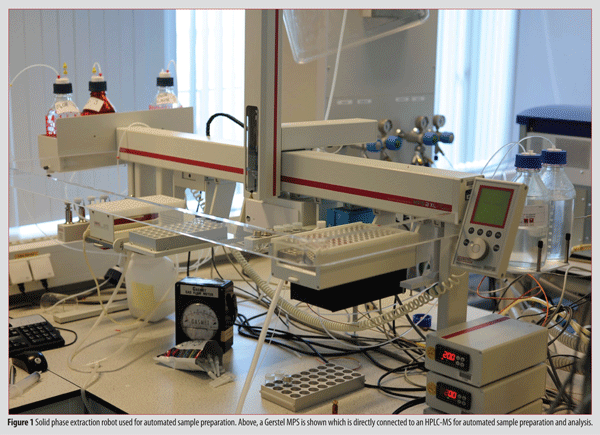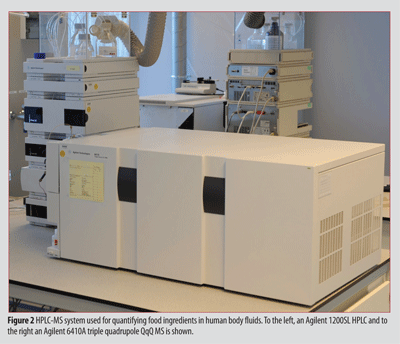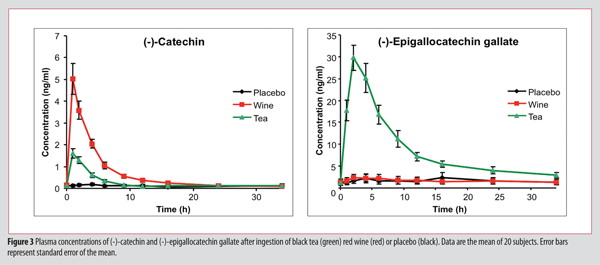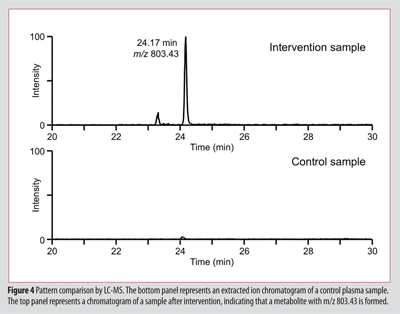Using LC-MS to study the fate of food ingredients in the human body
- Like
- Digg
- Del
- Tumblr
- VKontakte
- Buffer
- Love This
- Odnoklassniki
- Meneame
- Blogger
- Amazon
- Yahoo Mail
- Gmail
- AOL
- Newsvine
- HackerNews
- Evernote
- MySpace
- Mail.ru
- Viadeo
- Line
- Comments
- Yummly
- SMS
- Viber
- Telegram
- Subscribe
- Skype
- Facebook Messenger
- Kakao
- LiveJournal
- Yammer
- Edgar
- Fintel
- Mix
- Instapaper
- Copy Link
Posted: 12 May 2010 | Christian H. Grün & Hans-Gerd Janssen, Unilever Research and Development, Advanced Measurement & Data Modelling | No comments yet
The human body is designed for effectively extracting nutrients from the food we eat. The nutrients provide the body with energy, but in addition, they also provide the building blocks for cell growth. More recently, it has also been realised that specific food ingredients can be associated with a direct stimulating effect on our health. Examples are the multiple unsaturated fatty acids and plant sterols which actively reduce blood cholesterol levels. Others are flavonoids; natural antioxidants found at large quantities in tea, red wine, cocoa, fruits and vegetables. For example, a diet rich in flavonoids is associated with reduced risk of cardiovascular disease. In particular, consumption of tea, grape (juice), and red wine has been shown to improve markers of vascular function.
The human body is designed for effectively extracting nutrients from the food we eat. The nutrients provide the body with energy, but in addition, they also provide the building blocks for cell growth. More recently, it has also been realised that specific food ingredients can be associated with a direct stimulating effect on our health. Examples are the multiple unsaturated fatty acids and plant sterols which actively reduce blood cholesterol levels. Others are flavonoids; natural antioxidants found at large quantities in tea, red wine, cocoa, fruits and vegetables. For example, a diet rich in flavonoids is associated with reduced risk of cardiovascular disease. In particular, consumption of tea, grape (juice), and red wine has been shown to improve markers of vascular function.
The human body is designed for effectively extracting nutrients from the food we eat. The nutrients provide the body with energy, but in addition, they also provide the building blocks for cell growth. More recently, it has also been realised that specific food ingredients can be associated with a direct stimulating effect on our health. Examples are the multiple unsaturated fatty acids and plant sterols which actively reduce blood cholesterol levels. Others are flavonoids; natural antioxidants found at large quantities in tea, red wine, cocoa, fruits and vegetables. For example, a diet rich in flavonoids is associated with reduced risk of cardiovascular disease. In particular, consumption of tea, grape (juice), and red wine has been shown to improve markers of vascular function.
Some food ingredients are absorbed quickly, without major conversion; others persist to the colon where they are extensively metabolised. For improving our understanding of their presumed health effects, gaining insight into the metabolic fate of healthy food ingredients is essential.
When studying the fate of food ingredients in the human body, an approach similar to that used for studying pharmaceuticals is applied. The study comprises four parameters: adsorption, distribution, metabolism and excretion (ADME). Studying the metabolic fate of food ingredients typically involves a human intervention study where an intervention is compared with a placebo treatment. Samples (typically blood, urine and/or faeces, but occasionally also saliva) are taken and analysed. High- performance liquid chromatography coupled to mass spectrometry (HPLC-MS) is usually the technique of choice for the analysis of the samples. HPLC is used to separate the complex mixtures of compounds, whereas mass spectrometry provides the sensitivity and selectivity to identify and quantify food ingredients and their metabolites in the body fluid samples.
Sample preparation
Prior to the analysis of human body fluids, samples need appropriate preparation. Where urine is a relatively clean matrix which does not necessarily require pre-treatment, blood samples do. The common procedure starts with centrifuging the blood to separate blood cells from plasma. The plasma still contains large amounts of protein and lipids which may interfere with HPLC-MS analysis. Several procedures can be followed to isolate the compounds of interest from the plasma.
Dilute-and-shoot – Probably the least labour-intensive method is the so-called dilute-and-shoot method: to a certain amount of plasma, an organic solvent such as ethanol or methanol is added which induces precipitation of most plasma proteins. After centrifugation, the supernatant is injected into the HPLC-MS. A disadvantage of this method is that though many plasma proteins are removed, smaller proteins, salts, and other matrix compounds remain, which can contaminate the HPLC as well as the MS. In addition, many lipophilic compounds interact strongly with proteins and may be lost following this approach.
Liquid-liquid extraction – This may easily be the most labour-intensive method for sample preparation. To the plasma, an immiscible organic solvent such as ethyl acetate or methyl-tert-butylether is added and thoroughly mixed. Lipophilic compounds will enter the organic phase, whereas hydrophilic compounds remain in the aqueous phase. This process is generally repeated at least once or twice to obtain maximum recoveries. By carefully selecting the organic solvent, compounds of interest can be isolated very selectively, eliminating virtually all protein and salt contamination. This method, however, is not readily automated and requires intensive manual sample handling.
Solid phase extraction – Solid phase extraction (SPE) is based on the same principle as the HPLC technique. A short (disposable) column filled with a certain packing material is used to trap the compounds of interest. By selecting the right liquid composition for washing and eluting, the compounds can be isolated very specifically. The biggest advantage is that this method can be easily automated, which dramatically reduces manual intervention time when analysing large numbers of samples (Figure 1). A disadvantage is the time it takes to develop the method. Many parameters need to be considered, starting with the type of SPE column, the solvents for washing and the solvents for eluting the compounds. Frequently, when analysing more than one compound at a time, some of the compounds are well retained, whereas others are only partly retained or not retained at all, and again other compounds can be retained too strongly, preventing their elution from the column. If, though, all parameters are optimised and recoveries are good, the method is highly reliable and fast.


Quantification
Low levels of known food ingredients in the human body are typically quantified using LC coupled to a triple quadrupole MS (Figure 2), which combines sub parts-per-billion (ppb) sensitivity with highest selectivity. Here it should be realised that food ingredients are generally highly complex and regularly the exact composition is not known. As an example, a tea extract contains thousands of different compounds of which only a few are identified. Therefore, when quantifying tea flavonoids in the human body, a selection has to be made. An additional complication is the general lack of pure standards. Absolute quantification using mass spectrometry is only possible when calibration curves have been constructed using standards of known purity. This limits the total number of food ingredients that can be quantified even further. It has to be mentioned, though, that relative quantification remains a possibility even when standards are not available.


Sensitivity and selectivity is obtained by a technique called multiple-reaction monitoring (MRM). Ions are selected according to their mass-to-charge ratio in the first quadrupole of the mass spectrometer. The ions are then fragmented into smaller ions in a collision cell (traditionally the second quadrupole) and fragment ions are separated in the third quadrupole. By choosing the fragment ions on their intensity and specificity, highest sensitivity and selectivity can be obtained. In Figure 3, an example of the quantification of polyphenols in human plasma using HPLC-MRM-MS is shown. Plasma samples were obtained from a placebo-controlled cross-over study where 20 volunteers ingested black tea extract, red wine extract or placebo. Blood samples were taken at several time points during 24 hours and selected polyphenols were quantified by HPLC-MRM-MS.


Identification of metabolites
As mentioned before, food ingredients are extensively metabolised in the gut system. When studying the fate of these ingredients in the human body, also the metabolites should be taken into account. The identification of metabolites can be approached via five routes:
Radio-labelling – When feeding animals with radio-labelled compounds, the complete ADME pathway of that compound can be followed. The distribution in the body is generally visualised by preparing and scanning whole-body slices by radiography. Metabolites may be identified after extraction using a combination of radio-detection and mass spectrometry, generally preceded by chromatographic separation. It is needless to say that this technique is very invasive and has limited applicability to humans.
Prediction – In silico prediction in combination with literature data and common knowledge is used for predicting metabolic biotransformations of (food) compounds. Through LC-MS analysis, typically using a high resolution instrument such as a Q-TOF, but occasionally also performed on a triple quadrupole instrument, the metabolites can be identified and quantified, provided standards are available. The major drawback of this approach is that non-predicted metabolites will be missed.
Stable isotope dilution – With this method, compounds labelled with stable (non-radio-labelled) isotopes are mixed in a ratio of 1:1 with the target compound. Metabolites are identified by searching for fragment pairs in LC-MS. Because of the high sensitivity and mass accuracy, typically Q-TOF or Orbitrap instruments are used. The trick is to label that part of the compound that is not metabolised. Then, mass spectra can be screened on the known differences in mass between the target compound and the labelled-compound. Since both are metabolised identically, metabolites can be identified. A drawback of this method is the limited availability of labelled compounds. Further, to obtain sufficient sensitivity, rather large amounts of the labelled compounds should be consumed.
Pattern comparison – Simply speaking: compare chromatograms and search for differences. This is a preferred method when the number of samples is limited. For instance, it is used to compare a single intervention sample with a control sample. An example is given in Figure 4. Samples are analysed by LC-MS typically on a Q-TOF or Orbitrap instrument. Software tools are used for searching for differences between the two samples. In the ideal case, the differences reflect metabolites present in the intervention sample and absent in the control. The major drawback is that generally many false positives are created.


Metabolomics approach – Similar to the previous method, though used when large numbers of samples obtained from a (human) intervention study have to be compared. This method incorporates statistical tools, which implies that the larger the cohort, the more accurate the results. Advanced chemometrics is used to detect those compounds (metabolites) that are responsible for the differences between the intervention and the control group. As with the pattern comparison method, the results should be carefully checked to reduce false positives.
Developments
HPLC – The resolution of an HPLC separation is defined by the column length, particle size and the linear velocity of the mobile phase. A reduction in particle size will increase the resolution. At the same time, flow rates can be increased for higher analysis speed without sacrificing resolution. The downside is the increased pressure required for pumping the eluent through such a column.
During the last decade, several manufacturers have developed so-called ultra high pressure LC systems that can be used in conjunction with columns packed with a 1.7 µm stationary phase. The result is an increase in resolution, analysis speed and sensitivity. In combination with mass spectrometry, this provides new possibilities for the analysis of complex mixtures, e.g. of metabolites.
Mass spectrometry – Major developments are found in sensitivity, resolution and mass accuracy of mass spectrometers. For quantitative analysis, triple quadrupole instruments are developed that can handle the high flow rates and narrow peak widths that come with ultra high pressure LC separations. In addition, time-of-flight analysers are becoming increasingly suited for quantitative analysis, combining sensitivity with high mass accuracy. The advantage of a modern TOF analyser over a triple quadrupole instrument is that it can be used for both quantification and profiling, i.e. unknown compounds can be analysed and identified simultaneously with the quantification of knowns.
The structural elucidation of unknowns (e.g. metabolites) is greatly facilitated with the development of high resolution instruments. Instruments with a resolution of 40,000 kDa or higher and mass accuracies below 1 ppm greatly improve the structural elucidation. Newest developments are the incorporation of ion mobility spectroscopy into mass spectrometry. In ion mobility, ions are separated according to their molecular size in the gas phase. This enables the separation of compounds having identical mass but that differ in shape, which adds an additional dimension to mass spectrometry analysis.
Software – In a metabolomics type of approach, huge amounts of data are generated that need to be processed. Manufacturers of mass spectrometry instruments have developed software tools that enable the detection and identification of new metabolites.
High-performance liquid chromatography
High-performance liquid chromatography (HPLC) is a technique for the separation of (complex) mixtures. It makes use of a column, typically between 1 and 4.6 millimetres in diameter and 50 to 250 millimetres in length for analytical purposes, though many more dimensions exist for specific aims. The column is densely packed with small bead-shaped particles, which have a diameter typically between 1.7 and 10 µm. Through this column, a liquid flow is pumped at high pressure. Compounds of interest are injected and separated on the column based on their interaction with the column material: some compounds are retained better than others, and therefore, compounds elute at different times from the column.
With mass spectrometry (MS), the molecular mass of a compound can be determined. More precisely, compounds eluting from the HPLC system are ionised and the formed ions are separated based on their mass-to-charge ratio (m/z). Compounds can be identified either directly from their molecular mass or after fragmenting the ions (precursor ions) into smaller ions (product ions), a process called MS/MS. Several techniques for the ionisation have been developed, of which electrospray, MALDI, APCI, and APPI are the most common. For the separation of the ions, there is a choice of mass analysers. Quadrupole instruments are relatively cheap and are most commonly used for quantitative analysis, especially in the QqQ configuration. The ion trap is a mass analyser which allows almost endless cycles of fragmentation and is therefore well suited for the structural identification of unknowns. The time-of-flight (TOF) as well as the Orbitrap analysers are high-resolution instruments that provide extreme high mass accuracy (<1 ppm). They are also used for the structural identification of unknowns and are particularly powerful in metabolite identification.
Issue
Related topics
Food Fraud, Liquid chromatography–mass spectrometry (LC-MS), Spectroscopy









